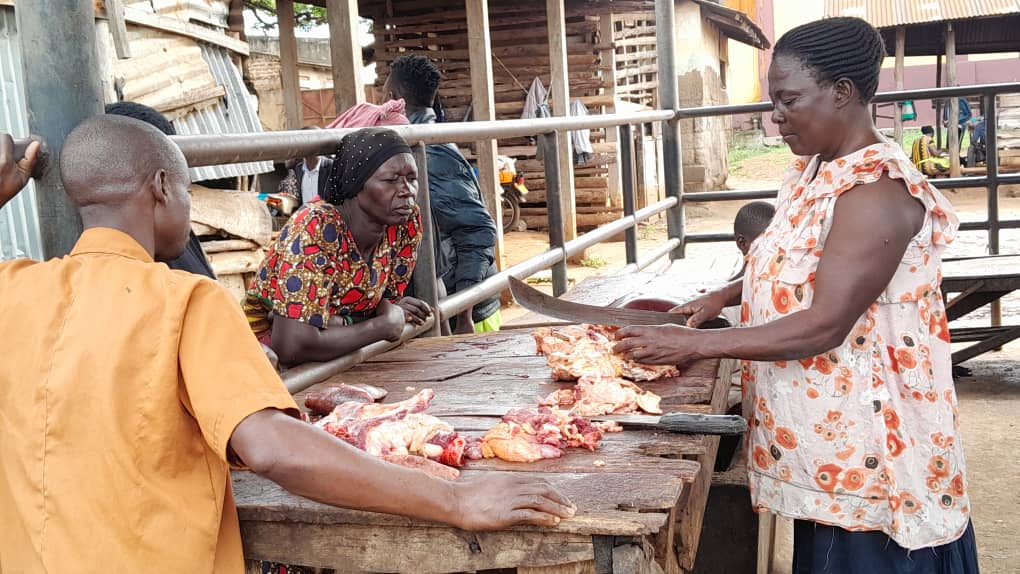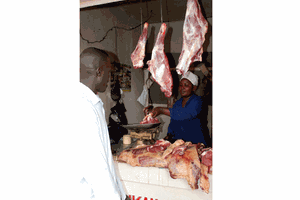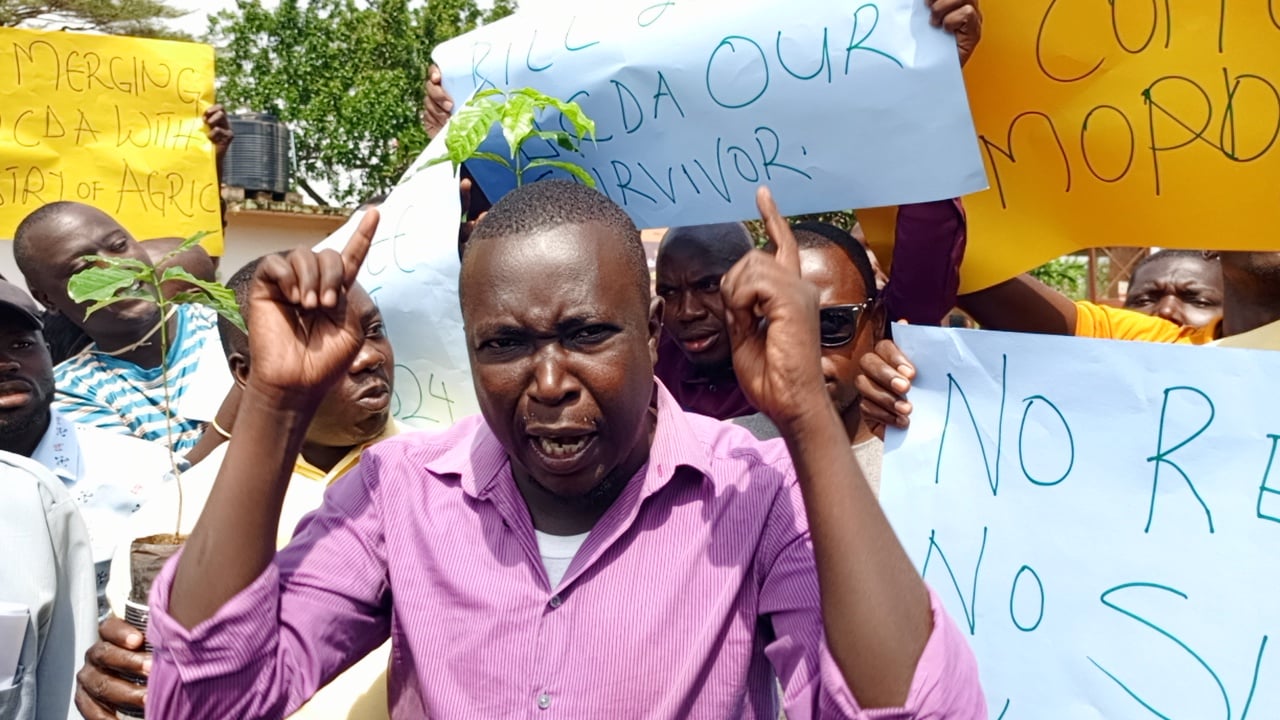
A woman cuts beef in Mbale Abattoir. Locals attribute the high prices to shortage of cattle. PHOTO/YAHUDU KITUNZI
The rising trend of exporting livestock to neighbouring countries has significantly impacted meat prices in eastern Uganda, Saturday Monitor has learnt. Local traders and farmers are increasingly finding it more profitable to sell their animals across borders, where demand is high, resulting in reduced supply of livestock for local markets in the region. This shift has led to increased meat prices, particularly beef and goat, causing concern among consumers and local butchers. The neighbouring countries, especially those with higher demand for meat, are willing to pay high prices for livestock.
“Uganda is exporting animals to our neighbouring countries [which could be impacting the local market],” Mr Yakubu Hasango, a cattle trader in Butaleja District, said, adding that the price of cattle has risen from Shs1.2m to about Shs2m. Mr Hasango also said meat price has gone up due to traders paying exorbitant fees to village chairpersons, parish, district, and inspectors.
Cattle shortage has pushed beef prices from Shs12,000 to Shs16,000 per kilogramme, and goat meat from Shs16,000 to Shs20,000. Several districts, including Mbale, Soroti, Tororo, Budaka, Butaleja, Namutumba, among others, have been affected, straining household budgets. Mr David Lokoris, a trader in Amudat District, predicted that the prices will more than double in the coming months due to livestock shortages. “The meat prices have for the last two months been increasing to the detriment of locals,” Mr Lokoris said.
Others attribute the high price of meat to the ongoing security operations against some traders involved in the theft and sale of livestock. The crackdown on illegal cattle trading in the eastern region has seen security forces intensify operations, with some traders incarcerated. The operation follows the rising reports of cattle theft, which has disrupted the local meat supply chain and led to soaring meat prices. We discovered that the stolen cattle, often sold at reduced prices on the black market, had previously undercut local farmers and traders, allowing illegal traders to thrive. With the ongoing enforcement efforts, the availability of affordable meat has plummeted, causing prices to increase significantly in local markets.
Mixed feelings
Farmers and legitimate cattle traders are expressing mixed feelings about the ort the initiative to protect their livestock and restore fair market conditions, they are al[1]so concerned about the long-term impact on supply. Some worry that the arrests might lead to shortages if the demand for meat continues to outpace the available supply.
Residents in the region have repeatedly raised concerns about skyrocketing meat prices. Our investigations further discovered that in Karamoja Sub-region, the farm gate prices for cows increased by anywhere between Shs500,000 and Shs700,000. For instance, a cow, which once cost Shs700,000 now goes for as much as Shs1.2m. In Mbale City, meat prices range between Shs15,000 and Shs16,000, depending on the location. This is from Shs12,000. In Tororo Town, a kilogramme of meat now costs Shs16,000 up from Shs13,000.
In Butaleja and Soroti, a kilogramme of meat costs Shs15,000 and Shs16,000, respectively. Mr Tom Wafula, a meat trader in Tororo Town, said they incur huge costs in transporting cattle. This is on top of other charges. He said cattle traders in the region are facing increasing financial pressure due to rising transportation costs.
“It has contributed to higher meat prices across the region. The cost of transporting cattle from rural areas to urban markets has surged, driven by fuel price hikes, road maintenance fees, and taxes levied at various checkpoints.” Mr Wafula said in a few months if nothing changes many people will not afford meat. Traders, he added, are facing challenges in meeting operational costs such as market levies, animal feed, and veterinary care.
Other factors at play Other traders have blamed the rising prices on exorbitant charges during the transportation of the animals and the recent outbreak of foot and mouth disease (FMD) in the cattle corridor districts. The corridor runs from Kotido and Moroto in the northeast through central Uganda to the southwest of Mubede, Rakai, Mbarara and Masaka. Economists and industry analysts confirm that today’s higher meat prices are a direct result of constrained supplies due to the labour shortage, higher input costs, labour and fuel, and strong consumer demand.
Mr Simon Opolot, a cattle trader, said the reduced number of cattle from the Karamoja cattle corridor has since triggered scarcity thus pushing up prices of meat. “We have shortages of animals in Karamoja Sub-region and yet the consumers are many. We had to increase the price,” Mr Opolot told Saturday Monitor. Mr Joseph Pulkol, another trader, said some middlemen hijacked this trade.
“These middlemen are the ones dictating the price and we also have to buy the cattle expensively and we also raise the high price in order to get some profit on the top.” Dr Micheal Kaziro, the Amudat District veterinary officer, said the price of cattle has increased in the cattle corridors due to several factors.
“The increase in meat prices starts from farm gate prices for animals in Karamoja Sub-region which supplies to other districts in eastern Uganda. The price of cattle has increased [from Shs1m to Shs1.5m],” Dr Kaziro said. “People are not selling their animals in Karamoja Sub-region because they have water at the moment. They are not under pressure to sell their cattle. People sell cattle cheaply during drought but right now we have enough water.”
According to Dr Kaziro, some areas are experiencing a lot of rainfall patterns. Mr Pulkol said they incur huge costs in transporting cattle on top of other charges. “The roads connecting to most villages in Karamoja where we get the animals are bad. The owners of vehicles we hire charge a lot of money, including other risks on the road, forcing us to price of meat,” he revealed.
Cattle theft Regional security operatives have linked the rising prices to theft of cattle. For instance, On August 17, the joint security forces conducted an intelligence-led operation in Mbale City to apprehend suspected cattle thieves and criminal gangs, where they recovered stolen animals. The operation followed the increasing public outcry about cattle theft. Maj Isaac Oware, the Uganda People’s Defence Force (UPDF) 3rd Division spokesperson, said some arrests were made after some animals and items were impounded. He said during the operation, about five suspects were arrested and eight cows recovered. Three vehicles and two motorcycles were also impounded.
Mr Rogers Taitika, the Elgon Regional Police spokesperson, said they have closed several butcheries in the city over cattle theft. He said they have so far arrested 75 people, including traders on allegations of stealing cattle in the region. “They use motor vehicles and motorcycles to transport the stolen animals at night. We are still tracing 23 cattle which were stolen,” Mr Taitika told Monitor.
According to a police crime report of 2023, as many as 8,442 cases of cattle theft were reported to the Force countrywide in the period under review compared to 7,975 cases reported in 2022.
This represented an increase in cattle thefts by 5.9 percent. The report indicates that Rwizi Sub-region registered the highest number of cattle theft in 2023 (946 cases), followed by East Kyoga with 612 cases, North Kyoga with 556 cases and Albertine with 575 cases while Elgon region registered 278 and Mt Moroto tallied 238. Mr Isma Mafabi, a trader in Sironko District, said as security operations continue, the hope is to stabilise the market and protect the livelihoods of honest farmers while ensuring that consumers can access meat at reasonable prices.
GOVT SAYS
The Ministry of Agriculture, Animal Industry and Fisheries (Maaif) figures indicate that livestock production in the country contributes seven percent to nine percent of the total GDP. According to the ministry, between 1991 and 2000, cattle population in Uganda increased from 5.1 million to 6.1 million and in 2008 the cattle population was found to be 11.4 million. Mr James Kutosi, the senior communication officer of Mbale City, attributed the increasing prices of meat to the price of cows coupled with transport costs.
“There are also market dues in cattle markets. Remember most of the cows slaughtered in the city come from outside the city.”
Dr Philip Wakimwere, the Mbale District veterinary officer, attributed the increasing price to the economic situation. He said the outbreak of FMD recently in the districts of Sironko, Manafwa, Namisindwa and Manafwa, partly affected the cattle trade. “We get cattle in the Karamoja Sub-region and the cost of transport increased. This has prompted the traders to also increase the price of meat,” Dr Wakimwere said. He also attributed the increase to urbanisation and the high population in the region.
“Beef is in high demand because many people are living in the town. The meat consumption is high and we have low number of animals.”
He disclosed that Bugisu Sub-region has only three cattle markets, including Bukigai and Bushika in Bududa District as well as Kimwanga in Mbale District. This, he added, forced the traders to buy animals in Karamoja.
Mr Rogers Taitika, the Elgon Regional Police spokesperson, urged community members to report any suspicious activities related to cattle trading, emphasising the importance of collective action in combating livestock theft.








